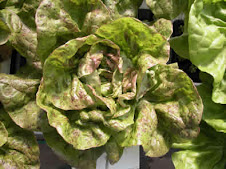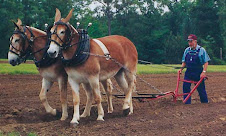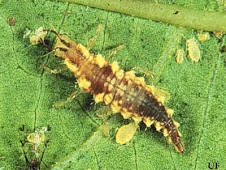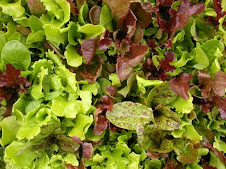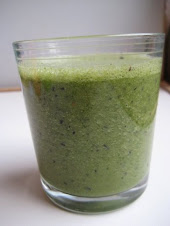Hi,
I've gotten three interesting questions from CSA members this week that I thought I would answer on here for the benefit of all:
Q. Why is my lettuce spotted? Is it supposed to be that way?
A. The lettuce that some of you received this week is a variety called "speckles" which originated in Holland in the 17th century. I guess the Dutch found the speckled look attractive, so they saved the seed. The variety found it's way first to Germany where it was very popular, and then on to North America in the 1790s. The original name "forellenschluss" comes from the German for "speckled like a trout."
Q. Why does my bag of berries smell like tobacco smoke?
A. This is actually the second time I've heard the same question. The first time I heard the question, I was obviously disturbed, and racked my brain as to how tobacco smoke could have interfaced with our produce. We always pack the berries in bags on Thursday mornings, and I have certainly never seen anyone smoke at the CSA packout- it is unthinkable. A week later, I was pulling bags off the roll, and smelled something odd- not exactly like tobacco smoke, but something less-than-pleasant. I suddenly realized that the bags themselves smell.
We started buying bags this year from a company called Trellis Earth. The bags are made from corn starch and are therefore bio-degradable, but indeed, they don't smell very good, especially when they have been in plastic CSA box for most of the day. The two people who asked about the smell said that their produce wasn't affected, and that only the outside of the bags smell. We would like to continue using bio-degradable bags, but certainly don't want to offend members. Please add your comments to this.
Q. Can you give me some food preservation suggestions?
A. Rather than answer that, I'll direct you to a few of good websites. Aside from canning, you can also blanche and freeze or dry excess produce. Check out these sites for more info:
http://www.extension.umn.edu/distribution/nutrition/DJ0555.html
http://www.cooksillustrated.com/images/document/howto/JA07_IlloSpread-FreezingProduce.pdf
http://www.recipes4us.co.uk/Cooking/Drying%20Food.htm
Thanks for the questions- please keep them coming...
Saturday, July 19, 2008
Thursday, July 10, 2008
Kids and Veggies
CSA member Kimberley Healey sent in this blog about getting kids to eat vegetables:
http://greatbigvegchallenge.blogspot.com/
http://greatbigvegchallenge.blogspot.com/
How are Fuel Prices Affecting Farmers?
I wrote this article last week for the Oregon State Extension Small Farms newsletter and thought I'd share it here:
We are all feeling the dramatic rise in the cost of fuel over the past few months. For the first time in years, Americans are changing their driving habits to reflect the ever increasing expense of filling up their gas tanks. Fuel prices are affecting most businesses, whether from increased expenses or decreased consumer spending, or both. So how has the rise in fuel affected small farmers? On a positive note, small, local farms are beginning to be more competitive with larger farms that truck or ship their produce across the country and world, and are more reliant of mechanization. Consumers increasingly understand the significance of supporting small farms in an effort to maintain local food security. Most farmers who sell their produce at the Rogue Valley Growers markets this year sell out routinely and can’t seem to bring enough of their products to market. At the Siskiyou Coop, we expanded our CSA membership and filled up. All of this seems to bode well for the small farmer…
But here is the bad news: the cost of farming has risen just as sharply as fuel prices. Not only is driving to distribution points and filling tractor tanks dramatically more expensive, but the cost of almost all inputs have also skyrocketed. From irrigation parts to fertilizer to animal feed, prices have doubled or tripled since last year. Nitrogen fertilizer, for example, is manufactured by natural gas, so an increase in natural gas prices has a direct and rapid effect on farmers and ranchers. Jackson County Soil and Water Conservation District’s Randy White, who has also been a rancher most of his life, noted that “even the price of twine has gone up!” White also commented that “with the cost of fertilizing my pastures tripled and the cost of feeding my cows in the winter doubled, I have to ask myself how long I want to stay in this business.” White Oak Farm’s Taylor Starr reports that the bottom line is that he is making less money this season. For small farmers, many of whom are struggling to stay in business, the increase in costs could be make or break. Josh Cohen of Barking Moon Farm explained that it is difficult to raise prices enough to accurately reflect costs without making customers balk and walk away. Consumer education about the costs of farming is an important piece of the puzzle.
So how do we make farming, such a vital part of our economy, landscape and very survival, financially sustainable?
Some farmers, like Chris Jagger of Blue Fox Farm, have used innovation to make their farms more fuel efficient. Chris uses a solar-powered electric cultivating tractor on his farm, and encourages other farmers to follow his lead. For information on converting an Allis Chalmers cultivating “G” tractor to an electric vehicle, check out this website http://www.flyingbeet.com/electricg/. Nationwide, a number of farmers are now switching over to animal power by modifying their equipment. While the training of animals to pull equipment can be initially time-consuming, the long term savings in fuel costs can be dramatic.
Necessity may not only be the mother of invention, but also the mother of collaboration. Here at the Siskiyou Sustainable Cooperative, we distribute our produce collectively, thus making more efficient use of equipment and fuel. In the OSU Extension Small Farms program, we are working to develop local markets for grains, hops and other products, so that producers and consumers will have less distance to travel. Farmers have a greater incentive to share equipment and other supplies, and reuse or salvage any items they can. While it may be a precarious time for small farms, there is an ever greater need for locally produced food and fiber.
We are all feeling the dramatic rise in the cost of fuel over the past few months. For the first time in years, Americans are changing their driving habits to reflect the ever increasing expense of filling up their gas tanks. Fuel prices are affecting most businesses, whether from increased expenses or decreased consumer spending, or both. So how has the rise in fuel affected small farmers? On a positive note, small, local farms are beginning to be more competitive with larger farms that truck or ship their produce across the country and world, and are more reliant of mechanization. Consumers increasingly understand the significance of supporting small farms in an effort to maintain local food security. Most farmers who sell their produce at the Rogue Valley Growers markets this year sell out routinely and can’t seem to bring enough of their products to market. At the Siskiyou Coop, we expanded our CSA membership and filled up. All of this seems to bode well for the small farmer…
But here is the bad news: the cost of farming has risen just as sharply as fuel prices. Not only is driving to distribution points and filling tractor tanks dramatically more expensive, but the cost of almost all inputs have also skyrocketed. From irrigation parts to fertilizer to animal feed, prices have doubled or tripled since last year. Nitrogen fertilizer, for example, is manufactured by natural gas, so an increase in natural gas prices has a direct and rapid effect on farmers and ranchers. Jackson County Soil and Water Conservation District’s Randy White, who has also been a rancher most of his life, noted that “even the price of twine has gone up!” White also commented that “with the cost of fertilizing my pastures tripled and the cost of feeding my cows in the winter doubled, I have to ask myself how long I want to stay in this business.” White Oak Farm’s Taylor Starr reports that the bottom line is that he is making less money this season. For small farmers, many of whom are struggling to stay in business, the increase in costs could be make or break. Josh Cohen of Barking Moon Farm explained that it is difficult to raise prices enough to accurately reflect costs without making customers balk and walk away. Consumer education about the costs of farming is an important piece of the puzzle.
So how do we make farming, such a vital part of our economy, landscape and very survival, financially sustainable?
Some farmers, like Chris Jagger of Blue Fox Farm, have used innovation to make their farms more fuel efficient. Chris uses a solar-powered electric cultivating tractor on his farm, and encourages other farmers to follow his lead. For information on converting an Allis Chalmers cultivating “G” tractor to an electric vehicle, check out this website http://www.flyingbeet.com/electricg/. Nationwide, a number of farmers are now switching over to animal power by modifying their equipment. While the training of animals to pull equipment can be initially time-consuming, the long term savings in fuel costs can be dramatic.
Necessity may not only be the mother of invention, but also the mother of collaboration. Here at the Siskiyou Sustainable Cooperative, we distribute our produce collectively, thus making more efficient use of equipment and fuel. In the OSU Extension Small Farms program, we are working to develop local markets for grains, hops and other products, so that producers and consumers will have less distance to travel. Farmers have a greater incentive to share equipment and other supplies, and reuse or salvage any items they can. While it may be a precarious time for small farms, there is an ever greater need for locally produced food and fiber.
Wednesday, July 2, 2008
Using Beneficial Insects
This week for the first time ever, we released beneficial insects into our fields. Tom and I had been noticing quite a lot of aphids on our kale seed crop (we are growing about 50 pounds of kale seed for a seed company in Maine) and considered our options: apply compost tea to give the plants a boost, spray all 1200 plants with soapy water to get rid of the pests, or cross our fingers and hope that the aphids would not affect seed yield too much. A friend of ours who is a budding entomologist is visiting and suggested we introduce a beneficial insect into the field.
The next day, I visited Natural Pests of the Garden, a store in Medford that sells beneficial insects, and bought 3,000 lacewing eggs. Green lacewing adults are about 1/2 to 3/4 inch long, and are yellowish-green with golden eyes and large, delicate netted wings. The Lacewing lays her eggs on foliage. The eggs are oval, pale green in color, and are attached to the end of a hair-like stem, which hatch just a few days after laying. The tiny larvae that emerges has a voracious appetite and will feed on aphids, small worms, insect eggs, mites, thrips, immature whitefly, and other insects. Our 5 year old son Sam was thrilled to discover the lacewing eggs had hatched yesterday, and now we are reveling in the sight of the larvae feeding on aphids.
Beneficial insects are just one part of an integrated pest management program (IPM) used on organic farms. Here at Wolf Gulch, we rotate the fields in which the same crop is planted, keep all our plants healthy with adequate nutrition and irrigation, manually remove problem insects when necessary, and occasionally use an organic pest control product, like diatomaceous earth, which helps control cucumber beetle populations.
We are excited to observe the impact of the introduced lacewings in our kale crop.
The next day, I visited Natural Pests of the Garden, a store in Medford that sells beneficial insects, and bought 3,000 lacewing eggs. Green lacewing adults are about 1/2 to 3/4 inch long, and are yellowish-green with golden eyes and large, delicate netted wings. The Lacewing lays her eggs on foliage. The eggs are oval, pale green in color, and are attached to the end of a hair-like stem, which hatch just a few days after laying. The tiny larvae that emerges has a voracious appetite and will feed on aphids, small worms, insect eggs, mites, thrips, immature whitefly, and other insects. Our 5 year old son Sam was thrilled to discover the lacewing eggs had hatched yesterday, and now we are reveling in the sight of the larvae feeding on aphids.
Beneficial insects are just one part of an integrated pest management program (IPM) used on organic farms. Here at Wolf Gulch, we rotate the fields in which the same crop is planted, keep all our plants healthy with adequate nutrition and irrigation, manually remove problem insects when necessary, and occasionally use an organic pest control product, like diatomaceous earth, which helps control cucumber beetle populations.
We are excited to observe the impact of the introduced lacewings in our kale crop.
Subscribe to:
Posts (Atom)

